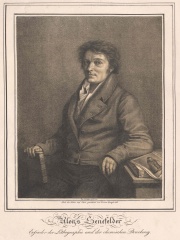
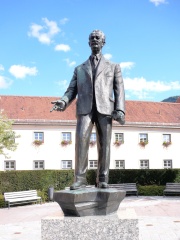
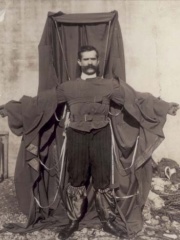
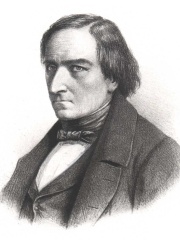
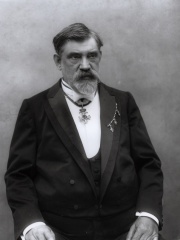
The Most Famous
INVENTORS from Czechia
Top 6
The following people are considered by Pantheon to be the most legendary Czech Inventors of all time. This list of famous Czech Inventors is sorted by HPI (Historical Popularity Index), a metric that aggregates information on a biography's online popularity.

1. Alois Senefelder (1771 - 1834)
With an HPI of 69.75, Alois Senefelder is the most famous Czech Inventor. His biography has been translated into 36 different languages on wikipedia.
Johann Alois Senefelder (born Alois Johann Nepomuk Franz Senefelder; 6 November 1771 – 26 February 1834) was a German actor and playwright who invented the printing technique of lithography in the 1790s.

2. Daniel Swarovski (1862 - 1956)
With an HPI of 68.17, Daniel Swarovski is the 2nd most famous Czech Inventor. His biography has been translated into 27 different languages.
Daniel Swarovski (24 October 1862 – 23 January 1956) was a Bohemian-born Austrian businessman, glazier, and jeweler. He was a founder of the Swarovski crystal dynasty.

3. Franz Reichelt (1879 - 1912)
With an HPI of 66.46, Franz Reichelt is the 3rd most famous Czech Inventor. His biography has been translated into 30 different languages.
Franz Reichelt (16 October 1878 – 4 February 1912), also known as Frantz Reichelt or François Reichelt, was an Austro-Hungarian-born French tailor, inventor and parachuting pioneer, now sometimes referred to as the Flying Tailor, who is remembered for jumping to his death from the Eiffel Tower while testing a wearable parachute of his own design. Reichelt had become fixated on developing a suit for aviators that would convert into a parachute and allow them to survive a fall should they be forced to leave their aircraft in mid-air. Initial experiments conducted with dummies dropped from the fifth floor of his apartment building had been successful, but he was unable to replicate those early successes with any of his subsequent designs. Believing that a suitably high test platform would prove his invention's efficacy, Reichelt repeatedly petitioned the Parisian Prefecture of Police for permission to conduct a test from the Eiffel Tower. He finally received permission in 1912, but when he arrived at the tower on 4 February he made it clear that he intended to jump personally rather than conduct an experiment with dummies. Despite attempts to dissuade him, he jumped from the first platform of the tower wearing his invention. The parachute failed to deploy and he plummeted 57 metres (187 ft) to his death. The next day, newspapers were full of illustrated stories about the death of the "reckless inventor", and the jump was shown in newsreels.

4. Josef Ressel (1793 - 1857)
With an HPI of 65.77, Josef Ressel is the 4th most famous Czech Inventor. His biography has been translated into 26 different languages.
Josef Ludwig Franz Ressel (Czech: Josef Ludvík František Ressel; June 29, 1793 – October 9, 1857) was a Bohemia-born Austrian forester and inventor who designed one of the first working ship's propellers. Ressel was born in Chrudim, Bohemia then part of the Holy Roman Empire ruled by the Habsburg monarchy, which became part of the Austrian Empire in 1804. His father Anton Hermann Ressel was a native German speaker, and his mother Marie Anna Konvičková was a native Czech speaker. He studied at the Linz Gymnasium, Budweis (in today's České Budějovice) artillery school, University of Vienna and the Mariabrunn Forestry Academy at Mariabrunn Monastery then near (now in) Vienna. He worked for the Austrian government as a forester in the more southern parts of the monarchy, including in Motovun, Istria. His work was to secure a supply of quality wood for the Navy. He worked in Landstrass (Kostanjevica on the Krka river in Carniola), where he tested his ship propellers for the first time. In 1821 he was transferred to Trieste, the biggest port of the Austrian Empire, where his tests were successful. He was awarded a propeller patent in 1827. He modified a steam-powered boat Civetta by 1829 and test-navigated it in the Trieste harbor at six knots before the steam conduits exploded. Because of this misfortune, the police banned further testing. The explosion was not caused by the propeller being tested, as many believed at the time. As early as 1804, the American John Fitch is credited with a screw propeller, which was unsuccessful. In 1836, the Englishman Francis Pettit Smith tested a screw propeller similar to Ressel's. The first transatlantic journey of a ship powered by a screw-propeller was by the SS Great Britain in 1845. Propeller design stabilized in the 1880s. Besides having been called "the inventor of the propeller," he was also called the inventor of the steamship and a monument to him in a park in Vienna commemorates him as "the one and only inventor of the screw propeller and steam shipping." He was also commemorated on Austria's 500 Schilling banknote in the mid-1960s (P139), which shows him on the front and the ship Civetta on the back. Among Ressel's other inventions are pneumatic post and ball and cylinder bearings. He was granted numerous patents during his life. Ressel also played an important role in the reforestation of the Karst Plateau near Trieste. A bronze statue of him was placed along the waterfront of Trieste on March 30, 2022. He died in Laibach (now Ljubljana, the capital of Slovenia) and was buried there in St. Christopher's Cemetery in the Bežigrad district. His gravestone is displayed today in Navje Memorial Park.
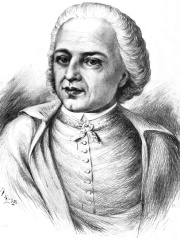
5. Prokop Diviš (1698 - 1765)
With an HPI of 55.24, Prokop Diviš is the 5th most famous Czech Inventor. His biography has been translated into 15 different languages.
Prokop Diviš O.Praem. (Czech pronunciation: [ˈprokop ˈɟɪvɪʃ]; 26 March 1698 – 21 December 1765) was a Czech canon regular, theologian, and natural scientist. In an effort to prevent thunderstorms, he inadvertently developed one of the earliest grounded lightning rods.

6. František Křižík (1847 - 1941)
With an HPI of 54.70, František Křižík is the 6th most famous Czech Inventor. His biography has been translated into 15 different languages.
František Křižík (Czech: [ˈfraɲcɪʃɛk ˈkr̝̊ɪʒiːk]; 8 July 1847 – 22 January 1941) was a Czech inventor, electrical engineer and entrepreneur.
People
Pantheon has 6 people classified as Czech inventors born between 1698 and 1879. Of these 6, none of them are still alive today. The most famous deceased Czech inventors include Alois Senefelder, Daniel Swarovski, and Franz Reichelt.
Deceased Czech Inventors
Go to all RankingsAlois Senefelder
1771 - 1834
HPI: 69.75
Daniel Swarovski
1862 - 1956
HPI: 68.17
Franz Reichelt
1879 - 1912
HPI: 66.46
Josef Ressel
1793 - 1857
HPI: 65.77
Prokop Diviš
1698 - 1765
HPI: 55.24
František Křižík
1847 - 1941
HPI: 54.70
Overlapping Lives
Which Inventors were alive at the same time? This visualization shows the lifespans of the 5 most globally memorable Inventors since 1700.

